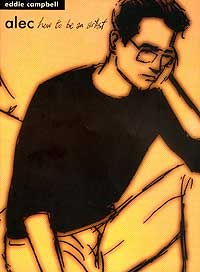
|
He sets his agenda in the first panel, writing, "How to successfully be an ARTIST (not be confused with 'becoming a successful artist')." By the second panel he's already cleverly amended the first statement by revealing one of his Bargains with Fate, "I will only lie in the service of Truth." This typically sly-humored, blink-and-you'll-miss-it juxtaposition makes Campbell's work one of the subtlest pleasures in the biz.
Campbell, born in Scotland, lately transplanted to Australia, earned his reputation among the comixcenti in the late 1980s for his semi-autobiographical works (collected last year as "Alec: The King Canute Crowd"). His mainstream success came when he drew "From Hell," the twelve part Jack-the-Ripper series by "superstar" comix-writer Alan Moore, the movie of which stars Johnny Depp and has a September release date.

|
"Alec: How to be an Artist," uses Campbell's long-time alter-ego, Alec MacGarry, to tell the story of his struggling years. Using this tether Campbell dives into and returns from extended caveats on subjects like the history of the industry during the '80s "boom-years," the difference between craft and art, and the challenges of remaining an Artist in such an historically disposable medium. Thus it bounces from essay, to history, to criticism, to autobiography in a way I haven't seen comix try before.
Campbell does better on some subjects than others. The history of the industry will leave more casual comix readers a bit confused, particularly if they live outside the U.K. But the parts of the book you could call "criticism," including a history of the graphic novel, are refreshingly opinionated. In between Campbell includes personal anecdotes of things both vastly important (marriage, birth) or utterly trivial, but memorable for their own sake (watermelon-sized holes in the curtains). Ultimately it reads with the voice of a friend sitting at the bar after his fifth pint, though admittedly this has its rambling downside as well.
Campbell does all of this in an easy-to-read layout consisting mostly of borderless panels defined by a running narrative above and an illustration below. Campbell has a sketchy style that captures the essence of a moment through the expression of his line, rather than minute details. Sometimes these black and white pictures are metaphorical, as when Alan Moore, during his first burst of success, rides a crazed chicken, and some times more illustrative, as with the landlady who gets broccoli stuck in her teeth. These shaky lines vibrate with life.
As an instructional book, "Alec: How to be an Artist," applies to only one person: Eddie Campbell. Campbell cops to this right in the title, with that "Alec" part. Other artists will do better by taking the book's combination of memoir and essay as an example of comix' mostly untested non-fiction possibilities. The rest of us casual readers will treat the book like a smorgasbord, and take away those very nice parts that appeal most to us.
"Alec: How to be an Artist" can be found in better comicbook stores and through Eddie Campbell's American agent Top Shelf Productions. Eddie Campbell also has a personal website
